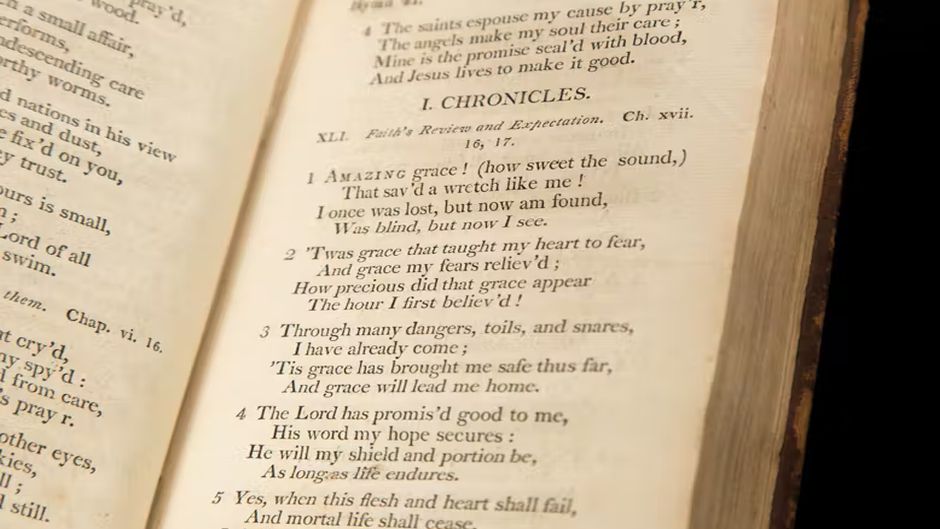250 years of Amazing Grace
John Newton, a former slave trader who became a pastor, presented his well-known hymn in 1773 to help his congregation understand 1 Chronicles 17:16-17.
Cowper and Newton museum of Olney · 12 JANUARY 2023 · 09:19 CET

John Newton’s hymn, Amazing Grace turned 250 on 1 January.
Newton, a former slave trader who became a pastor, presented it in 1773 to accompany his teaching on 1 Chronicles 17:16-17 at New Year’s Day service of the St Peter and St Paul Church, in the Buckinghamshire market town of Olney (England).
He used to write hymns, along with his good friend and local poet William Cowper, to accompany his weekly sermons and help the congregation understand the message better.
They compiled all the hymns they had composed in The Olney Hymns published in 1779, which included Amazing Grace, originally titled Faith's Review and Expectation.
The original melody was lost and the one we know today is the tune of the American hymnal The Southern Harmony, which dates from 1835.
Furthermore, the current final verse was not written by Newton. It first appeared in 1852 well-known novel Uncle Tom’s Cabin, and quickly became assimilated into the hymn.
“One of the best-known hymns”
Throughout the past 250 years, Amazing Grace “has become one of the best-known hymns in America and the rest of the world”, according to the American Library of Congress, which has “over 3,000 published recorded performances of the hymn by different individual musicians or musical ensembles”.
In the 20th century, the hymn became an African American spiritual, with a special relevance in the American civil rights movement.

Hymn hometown celebrations
The town of Olney celebrated the 250 anniversary with a special worship service held at Newton’s parish church of St Peter and St Paul.
Reverend Andrew Pritchard-Keens, current rector of the church led the service, pointing out that “Newton says that he was lost, but speaks of being found by God. My prayer for 2023 is that all who know God will be ever increasingly released to praise him. And all who don’t yet see how much God loves them, will come to know his ‘Amazing grace’”.
Reverend Rose Hudson-Wilkin, Bishop of Dover, delivered the sermon.
In addition to the service, the Cowper and Newton museum of Olney, the Amazing Grace Pilgrimage walk and other local associations, organised a short commemoration walk led by the high sheriff of Buckingham, the major of the city and the curate of St Peter and St Paul.
There were musical numbers from The Olney Hymns and 250 balloons were thrown to the air. The walk finished with all the participants singing Amazing Grace.

The Cowper and Newton museum of Olney has also launched a virtual exhibition with 20 items of its collection, which “explores some key moments in the life of John Newton”,
Worldwide tribute
The museum of the Bible in the United States has also launched an online exhibition to commemorate the anniversary, based on the 2017 temporary exhibition held at the museum in Washington DC.
“The exhibit leads you through Amazing Grace’s history, shows images of several hymnals that include the song, a timeline of some of the most pivotal moments in the song’s life and how each verse corresponds to a part of Newton’s New Year’s Day sermon”, explains the organisers.
Amazing Grace new orchestral piece
Award-winning poet Rommi Smith and leading operatic baritone Roderick Williams are writing the libretto and composing the music of a new orchestral and choral piece titled Forever.
It will be performed in recognition of anniversary by Britain’s Chineke Orchestra this summer, as part of the Milton Keynes International Festival.
“I want to look at the song’s enduring properties and its reach, as well as at the puzzle of Newton’s slave trading past”, Smith told The Guardian.
Before writing it, he talked to refugees, activists, clergy, asylum seekers, church-goers and some of the black residents living in Olney, who “regarded the song as a comfort, which is an idea I have used in the first stanzas, using the imagery of a warm coat, after speaking to some refugees from Ukraine”.
John Newton
John Newton was born in London in 1725. He followed in his father's footsteps and since he was a teenager his life was spent at the sea.
He became part of the slave trade, rising to the rank of captain and transporting slaves from Sierra Leone to the West Indies, but in 1748, on board The Greyhound, he got caught in a wild storm off Ireland.
Newton called on God and promised that, if his life was spared, he would devote the remainder of it to God’s service.
In 1754, he suffered a convulsive fit and was forced to give up his seafaring life, returning to live in England. He was ordained in the church of England in 1764 and appointed curate in Olney. Buckinghamshire.
In 1796, Newton wrote to his friend and campaigner William Wilberforce to urge him not to give up his campaign against slavery and stay in Parliament to accomplish the will of God.
Newton continued to preach until his death in 1807, nine months after British Parliament abolished the slave trade.
Published in: Evangelical Focus - culture - 250 years of Amazing Grace
